skip to main |
skip to sidebar
The year 2020 was dominated by the destruction caused by the global pandemic of Covid-19. Nature, of course, followed her normal cycle of the seasons.
In April 2020, post here, talked about Springtime in the garden of Brewood Hall, when the country was under government-mandated full lockdown. This was a return to a theme I'd first touched on in 2011 with a very short post Blossom Time at Brewood
By the start of June 2020, the garden was a riot of colour, from the vivid purple of the delphiniums planted the previous year to the rich red of roses. There was also the first flowering of the Hollyhock, also planted the previous year.

Delphinums (Brewood Hall garden 2020)

Roses (Brewood Hall garden 2020)

Hollyhock (Brewood Hall garden 2020)
A group of foxglove plants, both purple and white, were unexpected, but welcome, arrivals around the stump of the tree which had been removed in 2018 because of its dangerous condition. The removal of the tree is mentioned in the post More Brewood Hall Tree Maintenance.

Foxgloves (Brewood Hall garden 2020)
The two flower troughs at the front of the Hall, built by Rick Evans, continued to add colour until late in the year.

Flower trough at the front of the Hall (Brewood Hall garden 2020)
In 2020 the single rather ancient apple tree with its whitened, hollowed trunk surprised by giving a copious supply of fruit which, although tart, for the first time could almost be classed as eating apples. A number of apple pies resulted (not baked by the writer).

The single apple tree produced a good crop (Brewood Hall garden 2020)
My favourite tree remains the solitary Yew on the front lawn, which seems to grow wider every year. I see this as the sole remaining connection with the once-famous topiary at Brewood Hall, long removed, which I mentioned in the section 'Gardens and Orchards' of the post Notes on the History of Brewood Hall.

The Yew Tree (Brewood Hall garden 2020)
Following a summer of only slightly-relaxed 'social distancing' regulations, Autumn brought full lockdown again. The colourful displays around the garden persisted until late in the year but eventually the deciduous trees produced their crop of fruit, the leaves turned brown and dropped. On the large Barn, the Virginia Creeper turned from green to an attractive red-brown before it, too, lost its leaves.

Oak tree in October, showing acorn (Brewood Hall garden, 2020)

Virginia Creeper on Barn, October: Leaves starting to change colour and fall (Brewood Hall garden, 2020)
Right at the end of the year, after a Christmas holiday reduced by the Government to one day of restricted celebration in an attempt to control transmission of the Coronavirus, we had snow. There's more about this odd period in the post here.
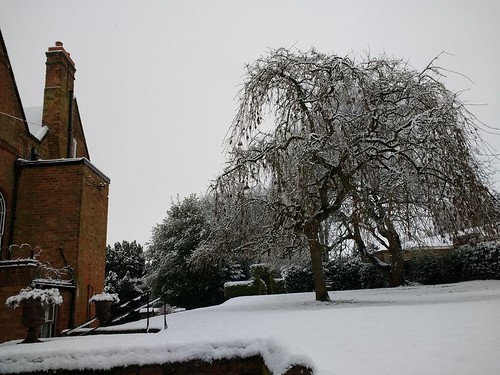 Snow at Brewood Hall, 28th Dec 2020
Snow at Brewood Hall, 28th Dec 2020
People throughout the world live in hope of less traumatic year in 2021.
My pictures
Pictures in this post can be viewed uncropped, where necessary, by clicking on the image. Selecting from the full 2020 album below allows viewing or downloading in various resolutions:-
Brewood Hall garden 2020
This article is a continuation of the topic London Underground - Traction Power Distribution
London Underground uses a fairly unusual fourth rail electrification system with a nominal voltage of 630 volts direct current (d.c.). At the time the system was being developed, the available insulation materials for traction motors made higher voltages problematic.
Normally, this voltage would be quoted at 'Full Rated Current'. But the current drawn from traction substations varies as trains start, coast, stop. Worst case is generally when two (or more) trains start away at the same time. The trip current on the High Speed Circuit Breaker feeding the positive rail at each sub station should be higher than the normal maximum current expected, otherwise 'nuisance tripping' can occur. But, of course, if a few thousand amps is being drawn by a traction section, there is a voltage drop on the track feed cables and the conductor rails so trains will experience a lower voltage which will change both according to the current drawn by each train and its position of the train in the traction section. The techniques of double end feeding, track paralleling and coupling of adjacent sections mean that a number of rectifiers may be contributing current to a single train. Although Kirchoff's Law allows you to work out the contribution of current from each rectifier, the situation will change second-by-second so, in general, all potential sources of current are paralleled to minimise voltage drop.
The nominal 630 volts d.c. is derived from incoming 11kV or 22kV 50Hz from the grid via transformers and semiconductor rectifier units. Nominal a.c. voltages are subject to variation as the load on the grid varies, also affecting the d.c. traction voltage.

Suite of modern traction circuit breakers (negative breakers at Marlborough Road Traction Sub Station during installation in 2011)

General view of Baker Street Traction Sub Station.

View inside a Acton Traction Sub Station on London Underground.
The fourth rail electrification system is nominally earth-free principally because the materials and construction used in early traction motors were prone to insulation failure introducing an earth. With earth-free distribution, it's possible to continue running if a train develops an earth or partial earth to either the positive or negative side of the supply. But you need to know about it, before a second train develops an earth to the other side and a High Speed Circuit Breaker detects an overcurrent and disconnects the supply.
As described in an earlier article, a potential divider of 220 ohms in series with 110 ohms is installed at the end of each traction sectionalisation to deliberately earth the traction with 220 ohms to the positive rail (outer), 110 ohms to the negative (centre) rail and the connection between the resistors earthed. Applying Ohm's Law to a nominal supply of 630 volts d.c. shows that each resistor takes a current of 1.909 amps and the positive rail sits at 420 volts positive to earth and the negative at minus 210 volts to earth (a 2:1 ratio). These voltages are only true if the 630 volts is nominal - as it goes up and down, the measured voltages to earth will go up and down, too. The voltages are only true if there is no connection to earth other than intentionally via the bleed resistors. In practice, the various spurious paths to earth may unbalance the ratio, offering a fairly simple means of monitoring the section for earth leakage. A system called 'TED' (Traction Earth Detection) is used to display the ratio at the Service Control Centre (formerly called Line Control Centre). If the ratio increases or decreases beyond preset limits, an alarm is automatically sounded to alert the Service Controller.

Traction Earth Detection (TED) equipment at the Metropolitan Line Service Control Centre.
To enable trains to increase demand on the traction distribution system (to support a combination of increased speed, increased service frequency and air conditioning requirements) all new equipment is designed to operate at 750 volts d.c. rather than 630 volts d.c. Operational changes are in progress to implement this change.
Related posts on this website
London Underground and Jan
London Underground: The Waterloo & City Line
Fourth Rail Electrification
London Underground - Traction Power Distribution
My pictures
There's a very patchy collection of pictures showing some of the London Underground lines on my 'Flickr' site (most of them are rather poor, I'm afraid). You can find them all here.
I've placed links to some of these albums below.
The various lines:-
Central Line.
White City (Central Line).
District & Circle Line.
Hammersmith & City Line.
Jubilee Line.
Metropolitan Line.
Northern Line.
Waterloo & City.
Service Control Centres (formerly Line Control Centres):-
District Line LCC.
Metropolitan Line LCC.
Waterloo & City (combined with general pictures).
Traction Sub Stations:-
Acton TSS.
Baker Street Substation.
Finchley Road TSS.
Marlborough Road Substation.
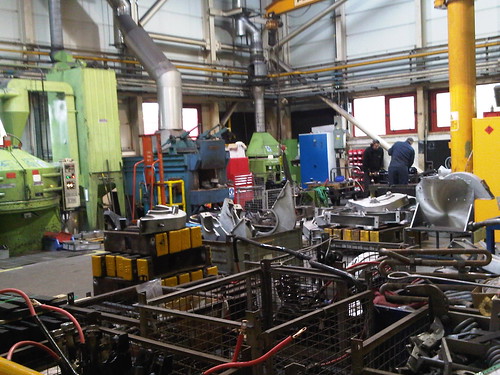
One corner of the Railway Engineering Works at Acton
Crewe, Swindon, Doncaster, Eastleigh, Acton - Acton? Perhaps Acton isn't one of the more famous railway works but London Underground established an important works at Acton. Mass transit sysytems are very intensively used and maintenance of rolling stock and infrastructure to the highest standards is essential.
My interest in Acton Works only started around 1995 when my firm became involved in work for London Underground, as described in the post London Underground and Jan. To be allowed 'behind the scenes' on any railway requires induction, safety training and various examinations matching the roles to be undertaken. An undergound fourth-rail electrified railway has particular risks and London Underground had a well-developed set of in-house training courses based at a Technical Training Centre at Acton Works. So I became a fairly regular visitor to Acton Works as I obtained different certifications and periodic re-certifications in connection with our work supplying Tunnel Telephone equipment, initially for the Jubilee Line Extension project and later for other London Underground lines. During these training visits, I saw glimpses of the work carried out around the sprawling Acton site, a mixture of old, modern and relocatable buildings.
Visits in 2006
During visits to REW Acton in connection with the design and supply of Tunnel Telephone equipment for a new installation at White City (necessitated by major changes to the London Underground depot in connection with the building of Westfield London Shopping Centre), I was able to take pictures of the external Signalling Training Facility that had previously intrigued me. Nearer the original Bollo Lane entrance to the site, a large concrete base provided with a fabric roof mounted an array of full-size working signalling equipment, including signals (colour light and disc shunting), point machines and train stops. On London Underground, points and train stops are electrically controlled but use compressed air to provide power, so the normal features of an air main running alongside the track provided with electro-pneumatic controls were also fitted. This allowing Signalling Technicians to receive training in maintenance of the various types of equipment in use on London Underground in a realistic environment supplementing training given in the adjacent Signal Training School, a large relocatable building provided with examples of various types of control system.

Signal Training facility, Bollo Lane, Acton with a variety of signals and air-operated points. The air main and control cables are along both sides, carried on posts.
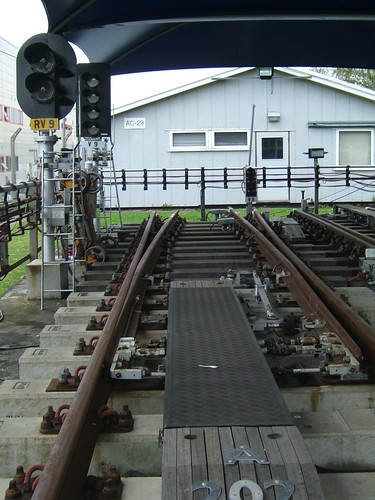
View in opposite direction of Signal Training facility. Left: Colour light signals Right: Turnout. The gabled building in the background is the Signal Training School.
Tour in 2011
During another business visit in March 2011, one of the London Underground staff arranged a fascinating, although brief, tour of part of the works. There wasn't time to get a proper understanding of the variety of work undertaken but I quickly realised the expertise available on the site. Below is a small selection of the things I saw.
Repair and refurbishment of rolling stock equipment forms a vital part of the work. In the reception area of one modern building, a part-sectioned motor wheelset for 1983 tube stock and part-sectioned gearbox for 92 tube stock were displayed.

Motor Wheelset for 1983 tube stock (part sectioned) on display at REW Trains Division, Acton.
In the Traction Motor Section of the works, rows of motors were being processed.

Traction motor section, REW Acton
Nearby, a series of massive jigs were provided for working on the pre-wired underbody control sub-assemblies.

Underbody control sub-assembly, mounted on jig.
Various signalling equipment is maintained at Acton, including heavy items like trainstops and various types of electro-mechanical relays.

Trainstop complete assembly, REW Acton

Shop for re-certifying electro-mechanical signalling relays (REW Acton)
I hadn't realised that surface-mounted cables feeding signalling equipment were normally pre-fabricated in standard lengths including moulded terminations, minimising time-to-exchange when replacement was necessary. I think these cables were bought-in complete but REW Acton also acts as a central stores for London Underground.

Prefabricated multicore cable for signalling showing moulded termination for fast connection to 12 terminal posts (REW Acton)
On an intensive mass transit system, every minute counts and London Underground has always provided clocks on stations to assist passengers and staff. But I was still surprised by the variety of clocks being repaired and regulated in the Clock Section. At the time of my tour, London Underground still had a few mechanical clocks at stations requiring weekly visits for winding!

The Clock Section (REW Acton)
Redundant D78 vehicles
During my 2011 visits, I saw a redundant D78 vehicle leaving the works on a low-loader. At the time, I thought the coach was going for scrap but I discovered afterwards these trains had been bought by Vivarail for conversion into modern, lightweight diesel-electric units for use on heavy-rail infrastructure. I caught up with these former D78 vehicles on a visit in 2018 to Quinton Rail Technology Centre (there's a post on that visit here).

Redundant D78 vehicle leaving REW Acton on low-loader in 2011.
My pictures
Pictures at REW Acton.
Books
There's a book on Acton Works titled ‘Underground Train Overhaul – The Story of Acton Works’ by J. Graeme Bruce/Piers Connor, published by Capital Transport Publishing in 1991 (ISBN 1 85414 134 1).
 'Traditional' methods of cargo handling still in use on the quayside
'Traditional' methods of cargo handling still in use on the quayside
in Sittwe, Myanmar.
Background
International shipping has always been important to trade but, within the last century, methods have been revolutionised by the introduction of standardised shipping containers ('containerisation') which replaced traditional cargo handling a piece at a time ('break-bulk cargo'). The enterprising North American haulier Malcolm McLean (1913-2001) accelerated this process in the 1950s. Effective designs by mechanical engineer Keith Tantlinger (1919-2011) allowed Freuhauf to build demountable shipping containers for McLean (Freuhauf invented the road trailer for motor trucks under the leadership of Augustus Freuhauf. The long and ultimately chequered history of Freuhauf is detailed by the Freuhauf Trailer Historical Society here).
McLean patented his designs, but gave a royalty-free license to the International Standards Organisation and the success of the innovation allowed goods to be efficiently moved around the world. There are Wikipedia articles about containerisation here and the containers used here. The most common containers are 20 feet or 40 feet long but shorter, longer and taller ('hi-cube') patterns are also used. Various special-purpose containers are provided either for carrying bulk liquids in tanks or products requiring refrigeration. The latter, called 'reefers', have built-in chilling equipment and loaded containers need external electric power to be connected whilst in storage or transit.
The success of the system was founded on the simplicity and reliability of the Twistlocks used in handling and securing containers - each container has eight Twistlock corner castings (4 on top, 4 underneath) which mate with either the handling crane, carrying vehicle (road trailer, rail vehicle or ship) or separate 'mid-locks' (allowing containers to be stacked). The need for manual labour was dramatically reduced and theft of cargo, whilst not eliminated, became a much more sophisticated crime. Road lorries could transport containers directly to or from the consignee or to a shipping agent who could ‘stuff’ or ‘strip’ part container loads. So, in docks all over the world, huge areas were concreted over to provide access for the container lorries and storage for the shipping containers coming and going.
The efficiency of container ships for intercontinental transport led to continuous increases in size of these vessels to reduce shipping costs. The size of ships that can pass through the major canals of the world (notably the Panama and Suez) sets the upper limit for ship dimensions. There's a clear explanation of the terms 'Panamax', 'Post-Panamax' and 'Panamax New' in Wikipedia here. A rough idea of the capacity of container ships is given by the 'TEU' - 'Twenty-foot equivalent unit', dscribed in Wikipedia here. Large container ships now have a capacity of 23,000 TEU.
Panama Canal
In 2008, I made a 'Partial Transit' of the Panama Canal, which is described here, with some additional information in the post The Panama Canal Railway. An additional set of larger locks opened in 2016, allowing ships up to 'Panamax New' to be handled - see the Wikipedia article here.
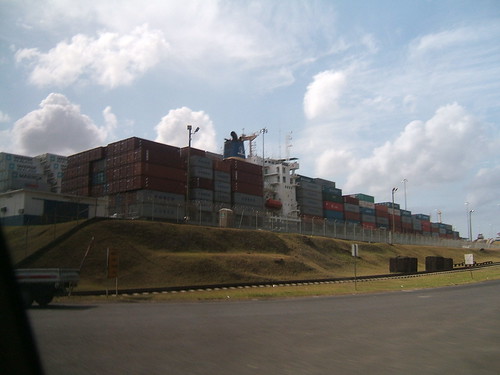
Container ship in Gatun Locks, Panama Canal
Suez Canal
I visited the lock-free Suez Canal in 2009, as described in the post Canal Zone, Egypt.

Maersk Line 'Sealand Slings' with deck container stacks 6-high in places heading north on the Suez Canal
Intermodal transport
Whilst massive container ships can economically move goods large distances, docking requires deepwater berths with specialist handling equipment so getting to the final destination usually requires transhipment to other transport modes - road, rail or sometimes smaller ships.
The significance of road trailers for motor trucks was mentioned in 'Background' above. Although local arrangements vary in different countries, articulated flatbed trucks for containers are a familiar sight. The Wikepedia article here gives a useful survey (and explains the various terms used to describe these vehicles).
But railways have been able to capture part of this market, moving containers between ports and inland distribution centres, from where final delivery may be by road. In the U.K. Freightliner offer over 37 direct routes between sea ports at Felixstowe, Southampton, Tilbury, London Gateway and Seaforth connected to 'major conurbations'.

Bournemouth by Train: View from Winchester platform 2, showing Up 'Freightliner' train passing.
At these terminals, rail-mounted goliath gantry cranes transfer containers to and from trains of special flat bogie wagons. The cranes are tailored to each site and many were constructed by famous bridge builders Sir William Arrol (who became Clarke Chapman in 1969). Freightliner describe the Seaforth (Liverpool) crane as follows:-
Terminal Crane Arrol 2-5-2 with with two cantilver outreaches built 1969. Specifically designed to load ISO containers on/off rail wagons stabled within the span of the crane and road wagons under one cantilver, the other cantilever used for the storage of containers. Rail span: 23.05m. S.W.L. under twistlocks: 32.0 tonnes. Lifting capacity: 20, 30, 40 and 45 foot containers at 13 lifts per hour.
Lawley Street, Birmingham, is an example of an 'inland port' or distribution centre.

Part of Lawley Street container depot.
Where containers are to be on- and off-loaded at destinations with fewer facilities, smaller ships (frequently provided with cranes on the vessel) are used.

View from the bridge of 'RMS St. Helena' en route from Cape Town to St. Helena, showing containers. The white-painted containers are 'reefers'. Note the two container-handling cranes in the 'stowed' position.
In my travels, I've seen a number of sea ports around the world modernised for handling shipping containers and a selection is illustrated below.
Liverpool
Liverpool and its docks have always fascinated me and many of my posts with the label Merseyside talk about docks and shipping on the River Mersey. Formerly operated by The Mersey Docks and Harbour Board, the docks are now run by Peel Ports whose website on its Liverpool facilities is here (and contains lots of interesting information, including data sheets for all the ship handling tugs operating on the Mersey).
In 1971, Seaforth Dock at the northern end of Liverpool Docks opened, with its group of strange-looking container-handling cranes for loading and unloading specialist container ships. This rendered many of the older docks redundant.There's a Wikipedia article here and an interesting aerial photograph by 'fragglehunter' here
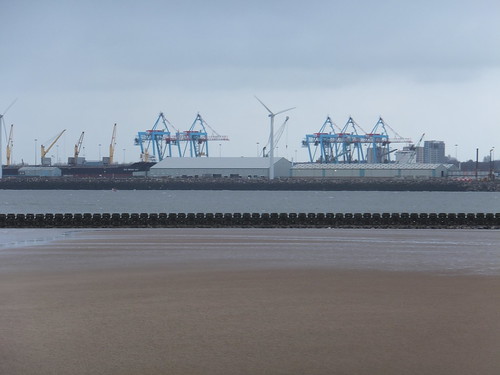 Royal Seaforth Dock seen from New Brighton.
Royal Seaforth Dock seen from New Brighton.
Peel Ports completed phase 1 of the new deepwater container port 'Liverpool2' in 2017, ultimately capable of handling two 380m-long 'Panamax New' vessels simultaneously - see the Wikipedia article here.

New Brighton by rail: View of Liverpool2 Dock from New Brighton, showing 4 of the 5 phase 1 container cranes with a group of young people in wet-suits on the beach.
There are two collections of my pictures showing Liverpool and Liverpool Docks
Southampton
I've visited Southampton a number of times over the years, but the pictures below are both taken from a train on a trip to Bournmouth in 2019 (described here. The Western Docks at Southampton now form a container port. The largest berth DP5, served by 5 container cranes, can accommodate 'Post-Panamax' vessels such as the 20,000 TEU 'MOL TRIUMPH' shown below.

Bournemouth by Train: View of DP World berth DP5 at Southampton after passing Millbrook station. The ship is MOL TRIUMPH.

Bournemouth by Train: View of DP World container cranes at berths DP1 to 4 at Southampton with Freightliner container crane in foreground. Note the 'Hoyer' tank container.
Yangon, Myanmar
In 2014, I walked along Strand Road, to see what was visible of the enclosed docks, as described here).
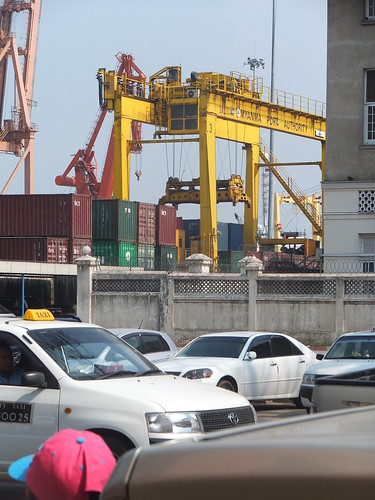
Yellow-painted Container Crane, showing the container-handling 'spreader' suspended from lifting cables, adjacent to Strand Road, Yangon, Myanmar.
Auckland, New Zealand
On the 'Tropic of Capricorn' trip early in 2020 (described here, I saw Auckland docks from both land and sea.
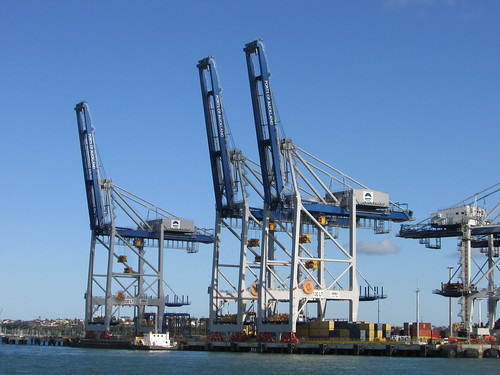
Container cranes on Fergusson Wharf, Auckland viewed from 'Caledonian Sky' (Tropic of Capricorn)
Haydarpasa (Istanbul), Turkey
Whilst exploring Istanbul's ferries in 2018 (described here, I saw the container port at Haydarpasa.
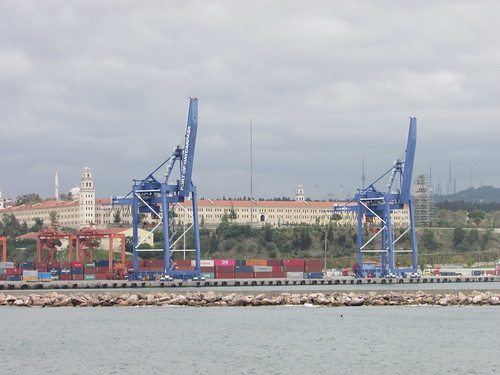
Port of Haydarpasa (Asian side) with two blue-painted container cranes and orange Straddle Cranes. In the background, the massive Selimiye Barracks (Istanbul's Ferries: Eminonu - Kadikoy).
Valparaiso, Chile
In 2016, a cruise to visit the Chilean fjords and the Antarctic Peninsula embarked from Valparaiso. The departure is described in the post 'Silver Explorer'

Container terminal, Valparaiso with Hapag-Lloyd container ship ‘Santa Teresa’.
Books
[1] 'Deep Sea and Foreign Going - Inside Shipping, the Invisible Industry that Brings You 90% of Everything' by Rose George, published by Portobello Books (ISBN: 078 1 84627 299 8).
[2] 'The Box: how the shipping container made the world smaller and the world economy bigger' by Marc Levinson, published by Princeton University Press (ISBN: 978-0-691-13640-0).









 Snow at Brewood Hall, 28th Dec 2020
Snow at Brewood Hall, 28th Dec 2020




























